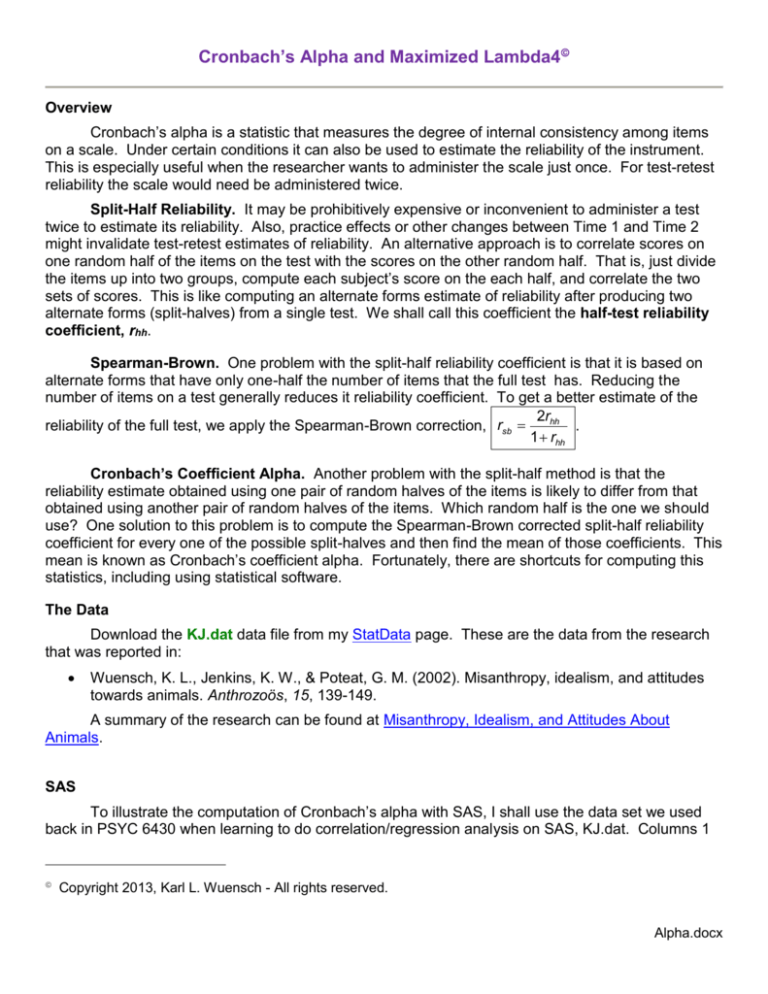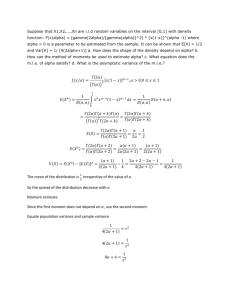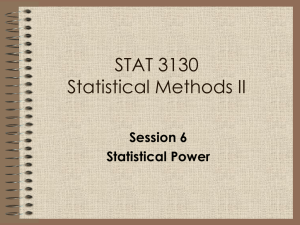
Cronbach’s Alpha and Maximized Lambda4
Overview
Cronbach’s alpha is a statistic that measures the degree of internal consistency among items
on a scale. Under certain conditions it can also be used to estimate the reliability of the instrument.
This is especially useful when the researcher wants to administer the scale just once. For test-retest
reliability the scale would need be administered twice.
Split-Half Reliability. It may be prohibitively expensive or inconvenient to administer a test
twice to estimate its reliability. Also, practice effects or other changes between Time 1 and Time 2
might invalidate test-retest estimates of reliability. An alternative approach is to correlate scores on
one random half of the items on the test with the scores on the other random half. That is, just divide
the items up into two groups, compute each subject’s score on the each half, and correlate the two
sets of scores. This is like computing an alternate forms estimate of reliability after producing two
alternate forms (split-halves) from a single test. We shall call this coefficient the half-test reliability
coefficient, rhh.
Spearman-Brown. One problem with the split-half reliability coefficient is that it is based on
alternate forms that have only one-half the number of items that the full test has. Reducing the
number of items on a test generally reduces it reliability coefficient. To get a better estimate of the
2rhh
reliability of the full test, we apply the Spearman-Brown correction, rsb
.
1 rhh
Cronbach’s Coefficient Alpha. Another problem with the split-half method is that the
reliability estimate obtained using one pair of random halves of the items is likely to differ from that
obtained using another pair of random halves of the items. Which random half is the one we should
use? One solution to this problem is to compute the Spearman-Brown corrected split-half reliability
coefficient for every one of the possible split-halves and then find the mean of those coefficients. This
mean is known as Cronbach’s coefficient alpha. Fortunately, there are shortcuts for computing this
statistics, including using statistical software.
The Data
Download the KJ.dat data file from my StatData page. These are the data from the research
that was reported in:
Wuensch, K. L., Jenkins, K. W., & Poteat, G. M. (2002). Misanthropy, idealism, and attitudes
towards animals. Anthrozoös, 15, 139-149.
A summary of the research can be found at Misanthropy, Idealism, and Attitudes About
Animals.
SAS
To illustrate the computation of Cronbach’s alpha with SAS, I shall use the data set we used
back in PSYC 6430 when learning to do correlation/regression analysis on SAS, KJ.dat. Columns 1
Copyright 2013, Karl L. Wuensch - All rights reserved.
Alpha.docx
2
through 10 contain the participants’ responses to the first ten items, which constitute the idealism
scale.
Obtain the program file, Alpha.sas, from my SAS Programs page. The simple way to get
Cronbach’s alpha is to use the NOMISS and ALPHA options with PROC CORR. I have also included
an illustration of how Cronbach’s alpha can be computed from the item variances and an illustration
of how to compute maximized 4 (lambda4) and estimated maximum 4.
SPSS
Boot up SPSS and click File, Read Text Data. Point the wizard to the KJ.dat file. On Step 1,
indicate that there is no predefined format. On Step 2, indicate that the data file is of FIXED WIDTH,
and that there are no variable names at the top. On Step 3 indicate that the data start on line one,
there is one line per case, and all cases should be read. On Step 4 you will see a screen like below.
To indicate that the scores for item one are in column one, item two in column two, etc., just click
between columns one and two, two and three……… ten and eleven.
On Step 5 , we don’t need to bother naming the variables, the default names, V1 through V10
will do just fine, but we do need to tell SPSS not to read the data that start in column 11. Highlight
column 11 and then for Data Format, select “Do Not Import.”
3
Go on to Step 6 and then finish. Now click Analyze, Scale, Reliability. Select V1 through V10
into the items box. Indicate model “alpha.”
Click on “Statistics” and select “Scale if item deleted.”
4
Click Continue, OK.
The Questionnaire and Results of the Analysis
Each item had a 5-point Likert-type response scale (strongly disagree to strongly agree). Here
are the items:
1.
2.
3.
4.
5.
6.
7.
8.
9.
10.
People should make certain that their actions never intentionally harm others even to a small
degree.
Risks to another should never be tolerated, irrespective of how small the risks might be.
The existence of potential harm to others is always wrong, irrespective of the benefits to be
gained.
One should never psychologically or physically harm another person.
One should not perform an action which might in any way threaten the dignity and welfare of
another individual.
If an action could harm an innocent other, then it should not be done.
Deciding whether or not to perform an act by balancing the positive consequences of the act
against the negative consequences of the act is immoral.
The dignity and welfare of people should be the most important concern in any society.
It is never necessary to sacrifice the welfare of others.
Moral actions are those which closely match ideals of the most "perfect" action.
Look at the output. With SAS, use the statistics for the raw (rather than standardized)
variables. The value of alpha, .744, is acceptable. There are two items, numbers 7 and 10, which
have rather low item-total correlations, and the alpha would go up if they were deleted, but not much,
so I retained them. It is disturbing that item 7 did not perform better, since failure to do ethical
cost/benefit analysis is an important part of the concept of ethical idealism. Perhaps the problem is
that this item does not make it clear that we are talking about ethical cost/benefit analysis rather than
other cost/benefit analysis. For example, a person might think it just fine to do a personal, financial
cost/benefit analysis to decide whether to lease a car or buy a car, but immoral to weigh morally good
consequences against morally bad consequences when deciding whether it is proper to keep horses
for entertainment purposes (riding them). Somehow I need to find the time to do some more work on
improving measurement of the ethical cost/benefit component of ethical idealism.
5
Computing Alpha from Item Variances
Coefficient alpha can be computed from the item variances with this formula:
n(1 I2 / T2 )
, where the ratio of variances is the sum of the n item variances divided by the
n 1
total test variance. The second part of the SAS program illustrates the application of this method for
computing coefficient alpha.
Maximized 4 (Lambda4)
H. G. Osburn (Coefficient alpha and related internal consistency reliability coefficients,
Psychological Methods, 2000, 5, 343-355) noted that coefficient alpha is a lower bound to the true
reliability of a measuring instrument, and that it may seriously underestimate the true reliability.
Osburn used Monte Carlo techniques to study a variety of alternative methods of estimating reliability
from internal consistency. Their conclusion was that maximized lambda4 was the most consistently
accurate of the techniques.
4 is computed as coefficient alpha, but on only one pair of split-halves of the instrument. To
obtain maximized 4, one simply computes 4 for all possible split-halves and then selects the largest
.5(2n)!
obtained value of 4. The problem is that the number of possible split halves is
for a test with
(n! ) 2
2n items. If there are only four or five items, this is not so bad. For example, suppose we decide to
use only the first four items in the idealism instrument. Look at the third part of the SAS program. In
the data step I create the three possible split-halves and the total test score for a scale comprised of
only the first four items of the idealism measure. Proc Corr is used to obtain an alpha coefficient of
.717. Then I use Proc Corr three more times, obtaining the correlations for each pair of split halves.
Those correlations are .49581, .66198, and .53911. When I apply the Spearman-Brown correction
(taking into account that each split half has only half as many items as does the total instrument),
2r
4
, the values of 4 are .6629, .7966, and .7005. The largest of these, .7966, is maximized
1 r
4. The average of these, .72, is Cronbach’s alpha.
( 2 2 )
If you have an even number of items, 4 21 A 2 B , where the three variances are for
T
half A, half B, and the total test variance. My program computes variances for each half and the total
variance, and then 4 is computed for each split-half using these variances. The maximized 4 is
.796. I also computed coefficient alpha as the mean of the three possible pairs of split-halves. Note
that value obtained is the same as reported by Proc Corr.
If you have an odd number of items, use the method which actually computes r for each splithalf. For example, I had data from a 5-item misanthropy scale. I created 10 split-halves (in each, one
set had only 2 items, the other had 3 items). The correlations, with the Spearman-Brown correction,
were .586, .718., .623, .765, .684, .686, .776, .687, .453, and .625. The highest corrected correlation.
.776, is the maximized 4. The mean of the 10 corrected correlations is Cronbach’s alpha, .66.
Estimating Maximized 4
When there are more than just a few items, there are just too many possible split-halves to be
computing 4 on each one. For our 10 item idealism scale, there are 126 possible split-halves, so
don’t even think about computing 4 for each. There are methods for estimating maximized 4. If you
are interested in such methods, read my document Estimating Maximized Lambda4.
6
I have archived some EDSTAT-L discussions of Cronbach’s alpha. They are available at
Discussion of Cronbach’s Alpha On the EDSTAT-L List.
Cronbach’s Alpha When There Are Only Two Items on the Scale
A colleague, while reviewing a manuscript, asked about Cronbach’s alpha for a scale with only
two items. The authors had reported the simple r between the two items. My response was that the
alpha would be higher than that because of the Spearman-Brown correction. To verify that I used
SPSS to compute r and alpha for two items selected from a scale that measures forgiveness. The
alpha for the full scale is well over .9.
Correlations
RAof3
RAof3
Pearson Correlation
Aof7
1
.679**
Sig. (2-tailed)
.000
N
468
468
There is only one possible split half when there are only two items, and the r for that split half
is, here, .679. Applying the Spearman-Brown correction,
alpha
2r
.679(2)
.81
1 r
1.679
which is what SPSS reports:
Reliability Statistics
Cronbach's
Alpha
N of Items
.807
2
Return to Wuensch’s Stats Lessons Page
Copyright 2013, Karl L. Wuensch - All rights reserved.




